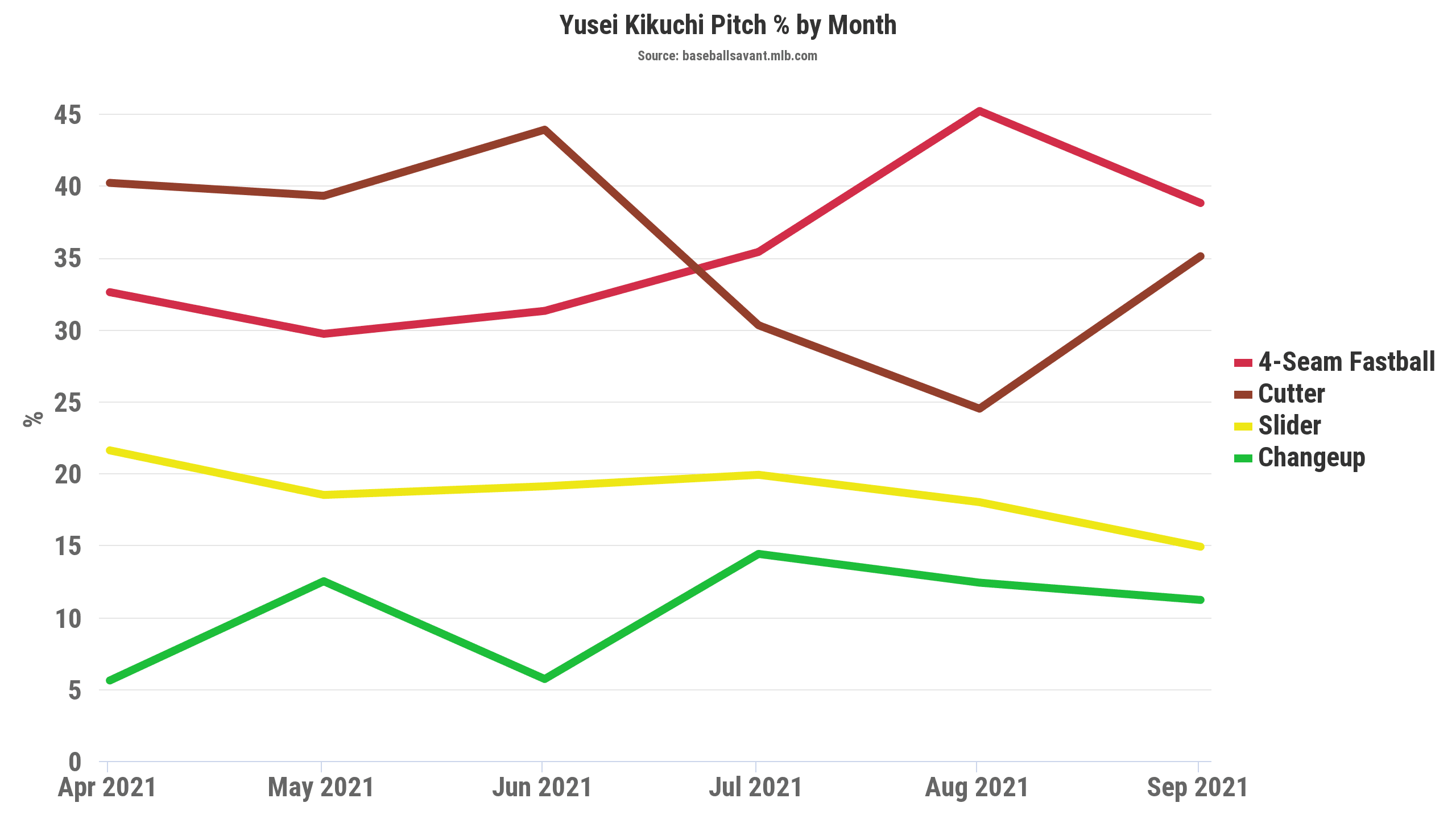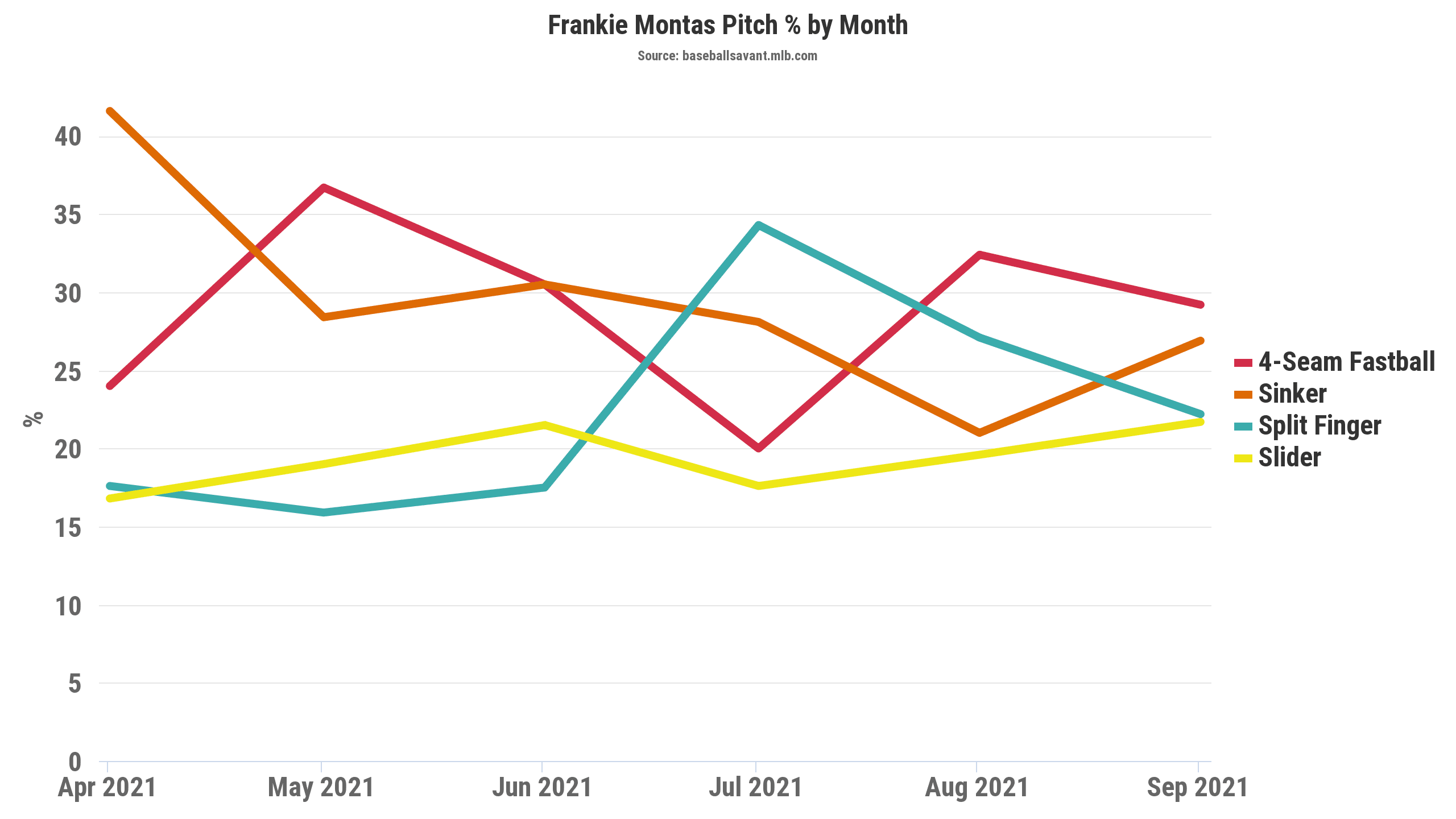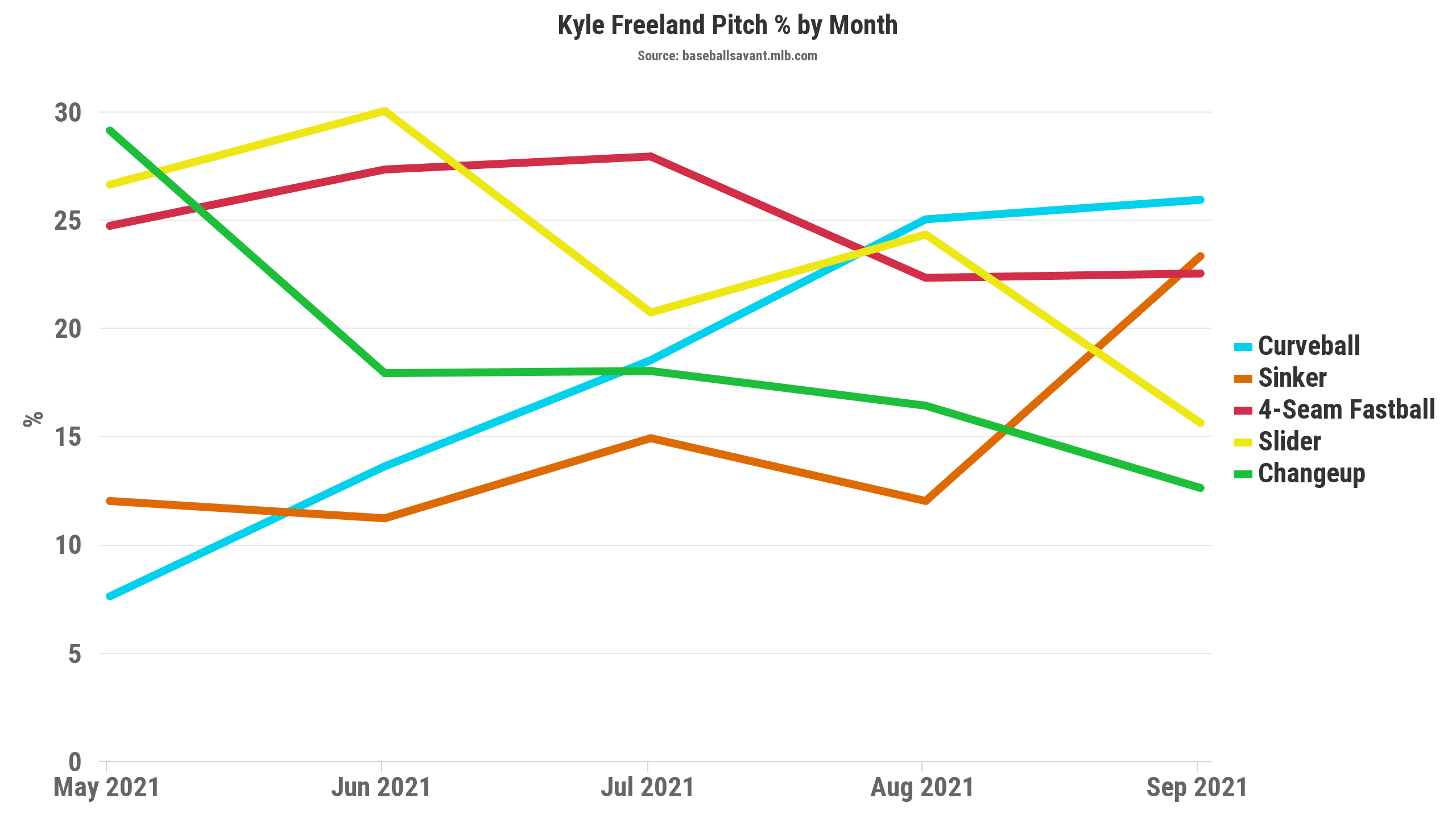Just throw the ball over the plate- it's that easy, right? Unfortunately, pitching is much more than that. In fact, it's a science. What are your best pitches? What's the optimal pitch usage for each pitch? How do they play off each other? There are so many variables that can be difficult to pin down. In a lot of ways, this is where some of the disconnects between more analytically-inclined individuals and old-school thinkers occur. The latter side will say that each pitch has a purpose, and needs to be established. The former side, meanwhile, will argue that if it's getting hit hard, what purpose is there to throw it?
For pitchers, making a notable change to their pitch mix can be difficult. You get accustomed to a certain pitch mix, so making changes could lead to an adjustment phase. Take Jesus Luzardo last year as an example. After being traded the Marlins, he increased his breaking ball usage significantly, which led to worse command. However, you wouldn't expect this to be a permanent issue. In fact, after increasing his swinging-strike rate significantly with a better pitch mix, I'd expect strong results from the young lefty.
Long story short, we need to just the process and wait for the results to follow. Kevin Gausman, Gerrit Cole, and Corbin Burnes are among the several pitchers who were able to make a pitch-mix change. In simple terms, they threw their better pitches more, and their worst pitches less. Hey, isn't that the goal all pitchers should strive for? Today, we are going to take a look at pitchers who could improve significantly by ditching their worst pitch. While this doesn't guarantee improved results, it would allow them to focus on their superior pitches, which should in turn lead to them becoming better pitchers.
Editor's Note: Our incredible team of writers received five total writing awards and 13 award nominations by the Fantasy Sports Writers Association, tops in the industry! Congrats to all the award winners and nominees including Best MLB Series, NFL Series, NBA Writer, PGA Writer and Player Notes writer of the year. Be sure to follow their analysis, rankings and advice all year long, and win big with RotoBaller! Read More!
Yusei Kikuchi, Free Agent: Cutter
It is easy to forget now, but do you know that Yusei Kikuchi made the All-Star game last year? After a slow start to the season, he posted a 2.77 ERA, 3.68 skill interactive ERA (SIERA), and 26.8% strikeout in his final 12 starts, earning him a spot in the midsummer classic.
Unfortunately, just because a pitcher makes the All-Star game doesn't mean their overall season was impressive. In the second half, the 30-year-old struggled mightily to the tune of a 5.98 ERA and 13.5% K-BB ratio. In the end, his ERA (4.41) was over four, while all of his numbers took a hit.
So, what was wrong with Kikuchi? Some of it certainly has to do with his fastball velocity. In May, he was averaging 96.1 MPH. Meanwhile, by September, that number was down to 94.3 MPH. Furthermore, with his spin rates declining more than you'd expect even with the drop in velocity, it's clear the crackdown on foreign substance abuse may have affected him negatively. All told, he'll need to make some adjustments to get back on track.
One change Kikuchi could make? Ditching, or severely decreasing the usage of his cutter. When we take a look at the metrics of each of his pitches, his cutter stands out in a negative way:
YUSEI KIKUCHI METRICS BY PITCH MIX
- Fastball: .362 expected weighted on-base average (xwOBA) allowed, 30.3% whiff rate
- Cutter: .426 xwOBA allowed, 19.5% whiff rate
- Slider: .268 xwOBA allowed, 31.2% whiff rate
- Changeup: .194 xwOBA allowed, 39.6% whiff rate
Kikcuhi's cutter is effective in inducing ground balls (58.5% GB), but that's about it. Despite all of that, it still allowed an 11.7% barrel rate last season, and the inability to get whiffs on it stands out. Especially since he has a vertical three-pitch mix with his fastball, slider, and changeup, the latter of which induces a lot of ground balls, a case can be made the cutter isn't needed. Interestingly, until the final month of the season, this seemed to be a change he was working towards making:

The decreased cutter usage didn't lead to strong results, but we have to trust the process here. As a free agent, here's hoping Kikuchi can sign with a team that is willing for him to go complete north/south approach with a three-pitch mix, sans the cutter. If so, there's plenty of reason why he can keep his ERA close to four, with more strikeouts as well. Now, we'll just have to wait and see where he ends up.
Casey Mize, Detroit Tigers: Sinker
When you're the first overall pick, expectations are going to be extremely high for you. When he first step foot at Auburn University, Casey Mize wasn't a heralded prospect- he wasn't even drafted coming out of high school. Yet, that doesn't tell the whole story.
Over his final 198.1 college innings, Mize posted a 34.19% strikeout rate with just a 3.2% walk rate. Simply put, those numbers are absolutely absurd. Thus, it's no surprise the Detroit Tigers made him the first overall pick in the 2018 MLB draft, hoping that he'd lead the way as the future ace of their pitching staff.
Although he dealt with some injuries, Mize quickly ascended up different levels, spending just one year in the minors before making his MLB debut in 2020. Heading into 2021, there were high expectations for him as MLB Pipeline's #11 overall prospect, and he did post a 3.71 ERA. Yet, this doesn't tell the whole story.
Clearly, Mize's ERA is going to be very hard to replicate. Not only did it come with a subpar 12.3% K-BB ratio, but also a 4.71 FIP and 4.45 SIERA. What led to the ERA boost? A .254 batting average on balls in play allowed (BABIP) and a 79.5% left-on-base allowed rate, each of which is going to be hard to sustain. I don't see Mize allowing just a 19.2% line-drive rate allowed, which will lead to more hits allowed, while more damage could be done with men on base.
Thus, for Mize to replicate his success, he'll need to make tweaks to his pitch mix. Honestly, his arsenal is impressive. He's able to miss bats with his fastball (25.3% whiff rate), while his slider and splitter each were highly regarded. Then, there's his sinker, which was hit extremely hard to the tune of a .412 xwOBA allowed and didn't exactly miss bats (13.1% whiff rate).
Sometimes, it's not as easy as just ditching one pitch, but for Mize, it is. There's no reason, after all, that his splitter shouldn't take a step forward next season:
Casey Mize, Nasty back-to-back Splitters. ? pic.twitter.com/HyrAgqaQMV
— Rob Friedman (@PitchingNinja) June 26, 2021
With that in mind, Mize could have a three-pitch mix between his fastball, slider, and splitter that can complement each other. All three of these pitches should miss bats, while the splitter's ability to induce ground balls should help compensate for the lack of a sinker. Honestly, I'd be fine if Mize pulled a Kevin Gausman and leaned on his fastball/splitter combination, which is what led to him being such a heralded prospect.
Considering his prospect pedigree and overall talent, there is room for Mize to grow into the pitcher he was expected to be. It is just going to take some tweaks to get there. Without them, we're likely looking at an ERA in the mid 4.00s at the best. If he does, though, there's a lot of upside here. I wouldn't be necessarily targeting him in redraft leagues or dynasty leagues, as his inflated ERA from last year doesn't make him a buy-low candidate at all, but I would closely monitor how his arsenal looks in spring training. If the sinker is gone, he becomes much, much more intriguing.
Frankie Montas, Oakland A's: Sinker (and Slider)
Every year, there are a few pitchers that put it all together and become standout performers. With a 2.63 ERA, 26.1% strikeout rate, and 20.3% K-BB ratio, Frankie Montas seemed to be one of those pitchers in 2019. Unfortunately, though, his season was limited to 96 innings pitched after he was suspended for 80-games due to the use of performance-enchancing drugs (PEDs).
After a shaky 2020 season, it was fair to question what Montas would bring to the table in 2021. After all, he hadn't pitched over 100 innings in an MLB season and had been rather inconsistent. The upside with his ability to miss bats was enough to make him a popular mid-round draft pick, but the excitement definitely withered after a poor start to the season.
Over the first three months of the season, Montas struggled to the tune of a 4.72 ERA. His underlying numbers (4.00 SIERA) were mostly fine, yet he was getting hit hard (10.6% barrel rate allowed) and seemed to be underachieving in terms of his strikeout rate (24% K). Clearly, something needed to change.
Fortunately, it did, and in a major way. During the course of the final three months of the season, Montas was absolutely dominant in every way:
- 16 GS, 99.1 IP, 2.17 ERA, 29.1% K, 8.4% BB, 15.5% Swinging-Strike Rate, 3.59 SIERA
As you can see, Montas missed more bats, leading to more strikeouts, while he was much better when it comes to limiting damage (6.6% barrel rate allowed). So, what unlocked this success? It wasn't a velocity bump, nor was it a major change in command. Instead, as you would expect based on the theme of this article, it has to do with his pitch mix.

Montas' sinker, with a .360 xwOBA allowed and 17% whiff rate, is certainly an inferior pitch to his four-seam fastball (.330 xwOBA, 24.6% whiff). Furthermore, his slider rated below-average for a breaking ball in both whiff rate (31.5%) and xwOBA (.348). On the other hand, his splitter, with an absurd 51.4% whiff rate and .178 xwOBA allowed, is one of the best pitches in baseball.
As you can see, Montas increased the usage of his splitter and relied less on his sinker as the season went on. It's no surprise that between July and August, when his pitch mix was most optimal, he was at his best: 31.5% strikeout rate, 3.31 SIERA, 16.9% swinging-strike rate. It is discouraging that he reverted back to his pre-July norms in September, but the upside was on full display.
We'll see what Montas' pitch usage looks like with a new coaching staff in Oakland, or if he ends up being traded. Either way, it's clear that he needs to lean less on his sinker and slider and enhance the usage of his splitter. If so, we could be looking at a true frontline starter. Oh, Frankie, how you remain the intriguing mystery that keeps on bringing us back in.
Kyle Freeland, Colorado Rockies: Changeup
The Rockies have had a difficult time developing pitchers, but Kyle Freeland was supposed to be the exception. Coming out of high school in Colorado, the Rockies made him the eighth overall pick in the 2014 draft. After throwing over 200 innings with a 2.85 ERA, many expected him to become the team's future ace.
Even at the time, though, there were reasons to be skeptical of Freeland. The ERA came with a 4.35 SIERA and just a 12.2% K-BB ratio, which are suboptimal numbers. With worse batted-ball luck and less runner left on base, his ERA ballooned to 6.73 in 2019, and he followed that up with a 15.1% strikeout rate in 2020.
Add in an injury that kept Freeland out until late May, and he likely wasn't someone on a lot of draft radars. With a 4.33 ERA and 20.4% strikeout rate in 120.2 innings, it's not as though he was a standout performer. However, this doesn't tell the whole story.
In 2021, Freeland started using his curveball more, and for good reason. While his slider lagged behind, his curveball induced a 40.3% whiff rate and .205 xwOBA allowed extraordinary numbers. Add in its ability to induce ground balls, and the curveball needs to be the premium pitch in his arsenal.
On the other hand, the 28-year-old's changeup has been a problem for him throughout his career. It has allowed a .387 wOBA, while it induced just a 17.2% whiff rate last year. Add in that the curveball was actually better inducing ground balls than his changeup, and there's no reason for him not to ditch the latter pitch. As the season went on, he started to realize this:

Fewer changeups, more curveballs- it was the perfect revelation for Freeland. From August on, he raised his strikeout rate to 23.7%. Take out his final two starts of the year, and that strikeout rate rises to 26.1%. In other words, the ability to miss enough bats and be effective enough to be a viable fantasy contributor is definitely in the cards for Freeland.
Am I saying that Freeland is going to become an ace? No, especially as long as he remains a Rockie. However, to see him make useful changes to his pitch mix, and combine that with more success to end the year is very enticing. As a late-round dart throw to use in specific matchups, you could certainly do worse! I guess in this case, you'll have to go a mile for Kyle.
Mike Minor, Kansas City Royals: Slider
Remember when Mike Minor was seen as one of the better up-and-coming young pitchers in the sport? He was drafted with the seventh overall pick in the 2009 MLB draft and posted a 3.21 ERA in 204.2 innings pitched by his second full season.
Unfortunately, injuries wiped Minor's 2015 and 2016 season, and he spent the entire 2017 season in relief. However, the Rangers still took a chance on him as a starting pitcher, and it worked out. In 2019, he managed to pitch 208.1 innings and posted a 3.59 ERA. For fantasy, that was enough to make him the 24th-most valuable pitcher, according to Fangraphs' 5x5 auction calculator.
Since then, though, things have not gone particularly well. Minor struggled to the tune of a 5.56 ERA in 2020 and compounded that with a 5.05 ERA in his first season as a Royal- he signed a two-year, $18 million dollar deal with them before the 2021 season. As a 34-year-old coming off of multiple poor seasons, there might not be any reason to be intrigued by him. Yet, this is still a pitcher with an interesting arsenal.
When you take a look at Minor's three off-speed pitches, one doesn't quite fit with the others:
MIKE MINOR OFF-SPEED PITCH wOBA ALLOWED (SINCE 2018)
- Slider: .355 wOBA (21.9% Usage)
- Changeup: .291 wOBA (19.6% Usage)
- Curveball: .274 wOBA (15.7% Usage)
For a visualization, here is Minor's xwOBA allowed per pitch:
As you can see, the difference between his slider and his other two off-speed pitches is remarkable. Yet, Minor continues to utilize his slider as his go-to off-speed pitch with two strikes. With how ineffective it has been, that certainly isn't the logical approach.
If Minor were to trade the slider for more usage of his curveball to go along with his changeup, I think we could see him miss more bats and be more effective. Now, that's a major if, and there isn't much reason to expect Minor to make this tweak. That being said, if we hear that he's using the slider less in spring training, or it becomes evident he's ditching it through his first couple of starts, he's someone who can offer value as a streaming option, especially in a favorable home ballpark. I guess you could say this would be no "minor" change!
Download Our Free News & Alerts Mobile App
Like what you see? Download our updated fantasy baseball app for iPhone and Android with 24x7 player news, injury alerts, sleepers, prospects & more. All free!

More Fantasy Baseball Advice
 RADIO
RADIO





















